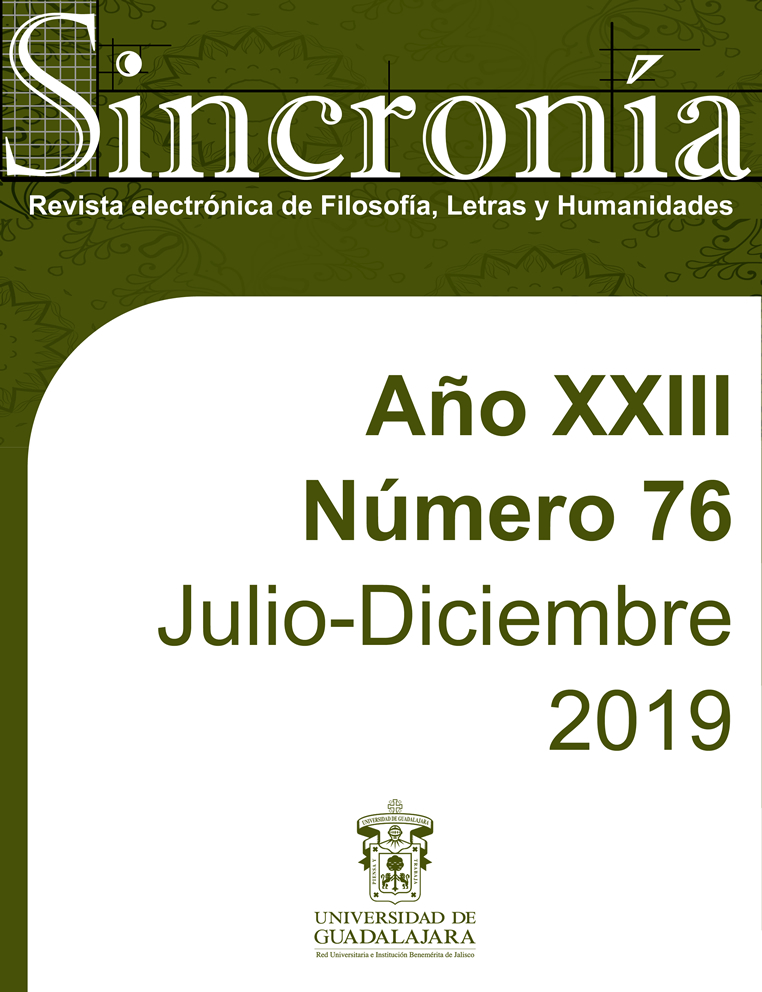The Reception and Analysis of the Performance of Widows, by Ariel Dorfman
Keywords:
Theatre., Critical review, Interpretation., History., Latin AmericaAbstract
The present study analyzes Widows, a play written by Ariel Dorfman, as a theatrical performance and a literary text. Through the critical reviews about various cases of performance of Widows in non-Spanish speaking countries, we find out how the drama on the disappeared of Latin America was received by audiences around the world. The critics of the United States, Brazil and South Korea showed different understandings about the theme due to the socio-historic experiences of each country and the direction of non-linguistic elements. The analysis of the script focuses on the non-realistic aspects that present a challenge when being interpreted on stage, to make suggestions on its direction. The narrator, the river, and the poetic character of the script can be more effective and coherent with appropriate performances.
Downloads
References
E59 Theaters (2018). Our Spaces. Obtenido el 19 de diciembre de 2018 de https://59e59.org/about/spaces/
Abuín, Á. (1997). El narrador en el teatro La mediación como procedimiento en el discurso teatral del siglo XX. Santiago de Compostela: Universidade de Santiago de Compostela.
Arias, J. (20 de noviembre de 2011). Brasil crea una Comisión de la Verdad sobre la dictadura, Internacional. El País. Internacional. Obtenido el 20 de diciembre de 2018 de https://elpais.com/diario/2011/11/20/internacional/1321743608_850215.html
Brown, M. R. (2013). Finding Peace by Chile’s Troubled Waters: Breaking the Dam of Memories in Ariel Dorfman’s Widows. South Central Review, 30(3), 40-60.
Cusato, D. A. (2004). La denuncia de los desaparecidos en Viudas de Ariel Dorfman. En Atti del Convegno di studi su La dittatura di Pinochet e la transizione alla democrazia in Cile: Trastoria e letteratura: Messina, 11-12 novembre 2003 (pp. 57-69). Messina: A. Lippolis.
Dorfman, A. (1996). Viudas. En Teatro 2: Lector, Viudas (pp. 86-191). Buenos Aires: Ediciones de la Flor.
Drake, S. (26 de julio de 1991). Stage Review: Widows an Exercise in Artifice. Los Angeles Times. Obtenido el 20 de diciembre de 2018 de http://articles.latimes.com/1991-07-26/entertainment/ca-45_1_stage-manager
Gomes, L. (2017). Viudas (Ariel Dorfman) e Viúvas (Ói Nóis Aqui Traveiz): entre textos e imagens [Versión electrónica]. Cavalo Louco, 17, 37-45.
Hemispheric Institute Digital Video Library. (2011). Viúvas performance sobre a ausência = Widows: performance about absence. Tribo de Atuadores Ói Nóis Aqui Traveiz collection, Obtenido el 20 de diciembre de 2018 de http://hidvl.nyu.edu/video/hdr7sskd.html
Hur, S. J. (2013). Evaluación de tres mejores representaciones del año 2012 elegidos por la Asociación Internacional de Críticos Teatrales en Corea. Korean Theatre Journal, 68, 142-144.
Isherwood, C. (21 de enero de 2008). The Women Who Protest Deaths of Man After Man. New York Times. Theater. Obtenido el 20 de diciembre de 2018 de https://www.nytimes.com/2008/01/21/theater/reviews/21wido.html
Kim, K. S. (2012). [Teatro (2)] La belleza de recitación del coro y la filosofía de espera: Viudas de Baeksugwangbu. Performances and Reviews, 78, 131-136.
Kim, N. S. (2014). El viento a las espaldas, Viudas. Korean Theatre Journal, 73, 68-72.
Lee, E. K. (2012). Reseña y cuestión: Resistencia para aclarar la verdad de la historia Viudas. Korean Theatre Journal, 66, 46-51.
Mail & Guardian. (4 de julio de 1997). The Women Who Still Wait. Obtenido el 20 de diciembre de 2018 de https://mg.co.za/article/1997-07-04-the-women-who-still-wait/
McClennen, S. A. (2010). Ariel Dorfman: An Aesthetics of Hope. Durham: Duke University.
Melo, C. (2013). Elegia e alegoria: Caminhos mnemônicos no Teatro do Ói Nóis Aqui Traveiz [Versión electronica]. Cavalo Louco, 13, 20-25.
Milaré, S. (2011). A arte de transformar a realidade em poesia [Versión electrónica]. Cavalo Louco, 10, 49-53.
Propst, A. (18 de enero de 2008). Widows. Theatermania. Obtenido el 20 de diciembre de 2018 de https://www.theatermania.com/new-york-city-theater/reviews/widows_12528.html
Sagrado. (2011a). Perfomance sobre a ausência [Entrada en blog]. Obtenido el 20 de febrero de 2019 de https://sagradocacete.wordpress.com/2011/08/11/blog-poaemcena-blogspot-com-confirma-dias-e-horario-perfomance-sobre-a-ausencia/
Sagrado. (2011b). Viúvas – Performance sobre a Ausência no 18º POA em Cena [Entrada en blog]. Obtenido el 20 de febrero de 2019 de https://sagradocacete.wordpress.com/2011/09/04/%C2%A8viuvas-performance-sobre-a-ausencia%E2%80%9D-no-18%C2%BA-poa-em-cena/
Shin, S. H. (2018). Widows by Ariel Dorfman. Obtenido el 20 de febrero de 2019 de http://shshin.creatorlink.net/index/view/18169
Sommer, E. (13 de enero de 2008). Widows. CurtainUp. Obtenido el 19 de diciembre de 2018 de http://www.curtainup.com/widows.html
Steuernagel, M. (2017). Here We Are Again: Performing the Temporality of the Brazilian Transition. TDR: The Drama Review, 61(4), 9-21.
Sube a escena la obra “Viudas” en el teatro Julia de Burgos de la UPR (9 de noviembre de 2010). Primera Hora. Obtenido el 16 de marzo de 2019 de https://www.primerahora.com/entretenimiento/farandula/nota/subeaescenalaobraviudasenelteatrojuliadeburgosdelaupr-442914/
Teatro X la identidad. (2001). Teatro del pueblo. Obtenido el 16 de marzo de 2019 de http://www.teatrodelpueblo.org.ar/obras/ciclo_teatro_de_la_identidad.htm
Thielman, S. (21 de enero de 2008). Widows. Variety. Obtenido el 20 de diciembre de 2018 de https://variety.com/2008/legit/reviews/widows-2-1200548872/
Teatro Sidarte. (2017). Viudas|EXIT. Obtenido el 20 de diciembre de 2018 de http://www.teatrosidarte.cl/cartelera_sidarte/viudas-exit/.
Downloads
Published
How to Cite
Issue
Section
License
Copyright (c) 2019 Hyerim Hong

This work is licensed under a Creative Commons Attribution-NonCommercial 4.0 International License.
You are free to:
- Share — copy and redistribute the material in any medium or format
- Adapt — remix, transform, and build upon the material
- The licensor cannot revoke these freedoms as long as you follow the license terms.
Under the following terms:
- Attribution — You must give appropriate credit , provide a link to the license, and indicate if changes were made . You may do so in any reasonable manner, but not in any way that suggests the licensor endorses you or your use.
- NonCommercial — You may not use the material for commercial purposes .
- No additional restrictions — You may not apply legal terms or technological measures that legally restrict others from doing anything the license permits.



























